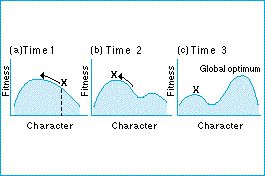Constraints on adaptation

As John Maynard Smith remarked,
"if there were no constraints on what is possible, the best phenotype would live forever, would be impregnable to predators, would lay eggs at an infinite rate, and so on”.
Adaptations in nature are not perfect, for various reasons.
Reasons why adaptations are not perfect:
• Natural selection may be a slow process, and time lags sometimes cause a species to be less than perfectly adapted.
• The dynamics of the developmental mechanisms serve to constrain which phenotypes are biologically realizable.
• Genetic constraints on adaptation occur when the heterozygote at a locus has a higher fitness than either homozygote. Because homozygotes will always exist, the population will never be perfectly adapted. This is a genetic constraint on adaptation. A famous example of this in humans is sickle cell hemoglobin.
• Some natural populations may now be imperfectly adapted because accidents of history pointed their ancestors in what would later become the wrong direction.
Figure: accidents of history. Historical change in adaptive topography leaves a species stranded on a local peak. (a) Initially, there is a single optimum state for a character, and the population (X) evolves to that peak. (b) As the environment changes through time, the adaptive topography has changed, and a new global peak has arisen. The species is stuck at the local peak, because evolution to the global peak would traverse a valley: selection does not favor evolution toward the global peak.
| Next |



